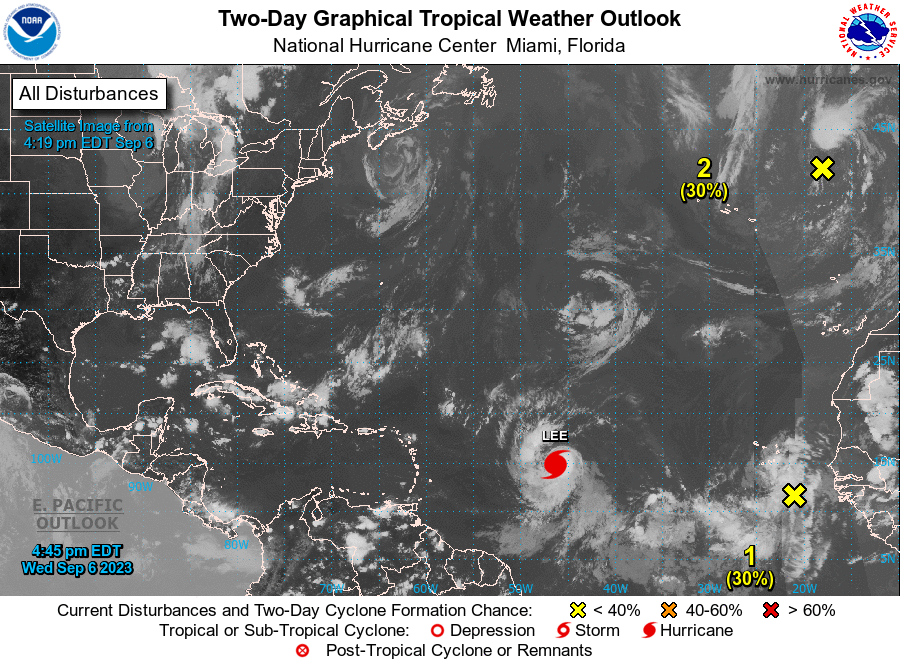Call Toll Free +1 855-856-TIPS
National Hurricane Center: “Lee” Turns Into Strong Hurricane While Another Storm “Jova” turns into Hurricane in the Eastern Southern Pacific
United States Of America – Tropical Storm LEE strengthens into Hurricane LEE and to possibly strengthen into a highly damaging and dangerous event by Saturday affecting the United States. As storms blast Europe and parts of America during high temps, poor air quality and wild fires still grasping from previous recent multiple natural and preventable disasters from west coasts to east coasts. Stay tuned and alert to local warnings, mandates and safety precautions. If able preventative supportive early supply shopping would be advisable for East Coasts and West Coasts spanning possible effected areas of Mexico, Baja and Southern California, Arizona, New Mexico and Texas.
Still to early to see if LEE will spare Florida and Puerto Rico for more northern East Coast targets. We will continue to monitor and alert.
Atlantic / Caribbean Hurricane Watch & Alerts
Eastern / Southern Pacific Ocean Watch & Alerts
NHC Storm Description:
6 Sep 2023 – 21:00 UTC …JOVA RAPIDLY INTENSIFIES INTO A CATEGORY FOUR MAJOR HURRICANE… As of 3:00 PM MDT Wed Sep 6 the center of Jova was located near 14.9, -111.7 with movement WNW at 15 mph. The minimum central pressure was 953 mb with maximum sustained winds of about 130 mph.
6 Sep 2023 – 15:00 UTC …JOVA CONTINUES TO RAPIDLY INTENSIFY… As of 9:00 AM MDT Wed Sep 6 the center of Jova was located near 14.2, -110.6 with movement WNW at 13 mph. The minimum central pressure was 972 mb with maximum sustained winds of about 105 mph.
6 Sep 2023 – 9:00 UTC …JOVA BECOMES A HURRICANE… …EXPECTED TO CONTINUE STRENGTHENING… As of 3:00 AM MDT Wed Sep 6 the center of Jova was located near 13.6, -109.6 with movement WNW at 9 mph. The minimum central pressure was 979 mb with maximum sustained winds of about 85 mph.
Resources and Additional RSS Feeds:
JOVA:
https://www.star.nesdis.noaa.gov/goes/floater.php?stormid=EP112023
LEE:
https://www.nhc.noaa.gov/graphics_at3.shtml?start#contents
Courtesy Of NOAA & National Hurricane Center:
A better understanding of tropical cyclones and hurricane hazards will help to make a more informed decision on your risk and what actions to take.
The major hazards associated with hurricanes are:
Before and after Hurricane Ike on the Bolivar Peninsula, TX – September 2008/USGS
Storm Surge & Storm Tide
Storm surge and large waves produced by hurricanes pose the greatest threat to life and property along the coast.
Storm Surge is an abnormal rise of water generated by a storm’s winds. Storm surge can reach heights well over 20 feet and can span hundreds of miles of coastline.
Storm Tide is the water level rise during a storm due to the combination of storm surge and the astronomical tide.
The destructive power of storm surge and large battering waves can result in loss of life, buildings destroyed, beach and dune erosion and road and bridge damage along the coast. Storm surge can travel several miles inland. In estuaries and bayous, salt water intrusion endangers public health and the environment.
Related Information
- Notable Storm Surge Events
- Storm Surge Risk Map for U.S. Coast
- Storm Surge Vulnerability Facts
- National Storm Surge Hazard Map
Learn more about storm surge from the NHC Storm Surge Unit.
Hurricane Frances Rainfall – Weather Prediction Center, NOAA
Heavy Rainfall & Inland Flooding
Tropical cyclones often produce widespread, torrential rains in excess of 6 inches, which may result in deadly and destructive floods. In fact, flooding is the major threat from tropical cyclones for people living inland. Flash flooding, defined as a rapid rise in water levels, can occur quickly due to intense rainfall. Longer term flooding on rivers and streams can persist for several days after the storm. When approaching water on a roadway, always remember Turn Around Don’t Drown.
Rainfall amounts are not directly related to the strength of tropical cyclones but rather to the speed and size of the storm, as well as the geography of the area. Slower moving and larger storms produce more rainfall. In addition, mountainous terrain enhances rainfall from a tropical cyclone.
High Winds
Tropical storm-force winds are strong enough to be dangerous to those caught in them. For this reason, emergency managers plan on having their evacuations complete and their personnel sheltered before the onset of tropical storm-force winds, not hurricane-force winds.
Hurricane‐force winds, 74 mph or more, can destroy buildings and mobile homes. Debris, such as signs, roofing material, siding and small items left outside become flying missiles during hurricanes. Winds can stay above hurricane strength well inland. In 2004, Hurricane Charley made landfall at Punta Gorda on the southwest Florida coast and produced major damage well inland across central Florida with gusts of more than 100 mph.
Atlantic and Eastern Pacific hurricanes are classified into five categories according to the Saffir-Simpson Hurricane Wind Scale, which estimates potential property damage according to the hurricane’s sustained wind speed.
Rip Currents
The strong winds of a tropical cyclone can cause dangerous waves that pose a significant hazard to mariners and coastal residents and visitors. When the waves break along the coast, they can produce deadly rip currents – even at large distances from the storm.
Rip currents are channeled currents of water flowing away from shore, usually extending past the line of breaking waves, that can pull even the strongest swimmers away from shore.
In 2008, despite the fact that Hurricane Bertha was more than a 1,000 miles offshore, the storm resulted in rip currents that killed three people along the New Jersey coast and required 1,500 lifeguard rescues in Ocean City, Maryland, over a 1 week period.
In 2009, all six deaths in the United States directly attributable to tropical cyclones occurred as the result of drowning from large waves or strong rip currents.
Find out more about rip currents on the NWS Rip Current Safety page.
Tornadoes
Hurricanes and tropical storms can also produce tornadoes. These tornadoes most often occur in thunderstorms embedded in rain bands well away from the center of the hurricane; however, they can also occur near the eyewall. Usually, tornadoes produced by tropical cyclones are relatively weak and short-lived, but they still pose a significant threat.
Find out more about tornadoes from the NWS Storm Prediction Center.




